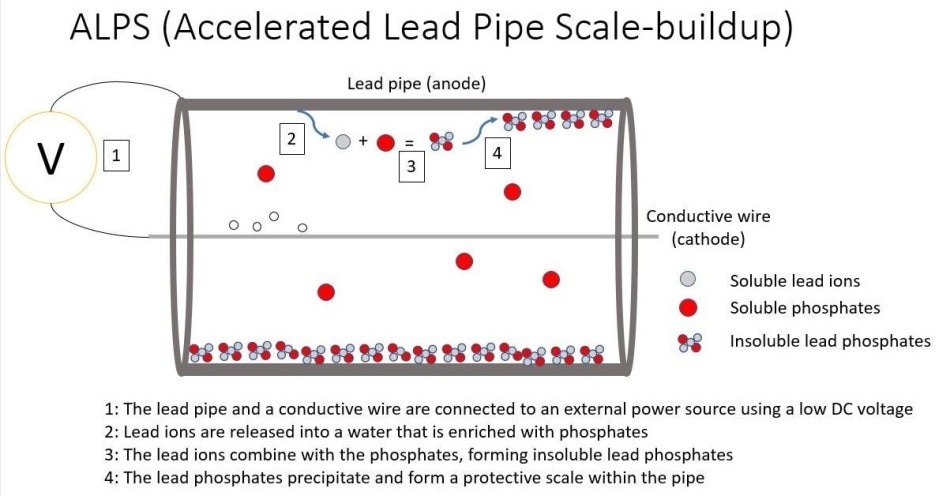Apr 4 2019
Discharge of lead from pipes into the water supply is a major public health issue. Moreover, if water sources or treatment routines are changed, the new chemistry can result in water distribution systems that were earlier safe to start discharging toxic lead, as the crisis in Flint, Michigan, showed a few years back.
 Briefly applying electricity to a lead pipe enables a safe coating to quickly form inside the pipe. (Image Credit: Gabriel Lobo)
Briefly applying electricity to a lead pipe enables a safe coating to quickly form inside the pipe. (Image Credit: Gabriel Lobo)
Now, researchers will illustrate a rapid and economical approach that could solve these issues and render lead pipes safe for transporting drinking water.
The scientists will demonstrate their outcomes at the American Chemical Society (ACS) Spring 2019 National Meeting & Exposition, on April 3rd, 2019. ACS, the largest scientific society in the world, is conducting the meeting until Thursday, April 4th, featuring almost 13,000 presentations on a broad spectrum of science topics.
More than 18 million people in the U.S. are currently at risk of developing health problems from lead leaching from pipes in their water distribution systems.
Gabriel Lobo, Doctoral Student, University of California, Berkeley
Gabriel Lobo is presenting the work at the meeting.
Lead poisoning in kids can lead to a wide variety of symptoms, such as learning difficulties, brain damage, and delayed growth and development. Adult exposure can lead to memory difficulties, miscarriages, high blood pressure, and other conditions.
In the past, many municipalities set up iron water mains that were linked to individual buildings via lead water pipes. Lobo described that in a usual lead pipe, chemicals in the water corrode the interior wall of the pipe, discharging lead ions into the water. To tackle this issue, municipalities mix corrosion inhibitors in the water. Eventually, these added phosphates react with the lead ions to produce compounds that build up on the interior wall of the pipe.
This layer, or “scale,” prevents other lead ions from discharging from the pipe into the water, rendering the pipe safe for water supply. However, in Flint, the drinking water source was changed to a different source with different water quality, and at the same time, the city of Flint discontinued using corrosion control measures. As a result, the protective scale dissolved, and harmful lead ions again leached into the water.
Lobo became engrossed in this problem when his adviser, Ashok Gadgil, PhD, started to concentrate on finding a way to solve the lead issues in Flint. Gadgil’s group is at the University of California, Berkeley, and Gadgil is also associated with Lawrence Berkeley National Laboratory.
After a few months of rigorous attempt, Gadgil and his team proposed an electrochemical approach to the issue. They applied a slight external voltage to a pipe sample to accelerate corrosion. Like always, the released lead ions subsequently reacted with phosphates in the water to develop scale. It took only a few hours for the process to form scale when compared to the standard scaling method, which takes a couple of years. Lobo believes that this process could rapidly bring back the protective coating in the pipes in Flint, where the pipes are still not recoated with scale.
The scientists have tested their process in the laboratory but it must be noted that they have not carried out any trials so far on lead pipes in the ground. For real-world applications, Gadgil visualizes to fix external connectors to a homeowner’s pipe at the water meter and at other intersections in the pipes and then threading another wire through the pipes to complete the circuit.
The idea is that we wouldn’t have to dig the whole pipe out, so we could keep the cost low. Replacing all the plumbing in one house would cost several thousand dollars, whereas our process would cost less than one-tenth of that.
Ashok Gadgil, PhD, University of California, Berkeley
Presently, the team is working with experts from a local water utility in California to find out the practical parameters for a test under real-world conditions. Furthermore, they are intending to perform a test by the end of this year at an Oakland school where normal scale deposit is not taking place in the pipes.
The scientists acknowledge support from Big Ideas and a Hellman Graduate Award.
Headline Science - Lead Pipes
Video credit: ACS